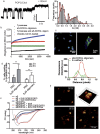DOPAL derived alpha-synuclein oligomers impair synaptic vesicles physiological function
- PMID: 28084443
- PMCID: PMC5233976
- DOI: 10.1038/srep40699
DOPAL derived alpha-synuclein oligomers impair synaptic vesicles physiological function
Abstract
Parkinson's disease is a neurodegenerative disorder characterized by the death of dopaminergic neurons and by accumulation of alpha-synuclein (aS) aggregates in the surviving neurons. The dopamine catabolite 3,4-dihydroxyphenylacetaldehyde (DOPAL) is a highly reactive and toxic molecule that leads to aS oligomerization by covalent modifications to lysine residues. Here we show that DOPAL-induced aS oligomer formation in neurons is associated with damage of synaptic vesicles, and with alterations in the synaptic vesicles pools. To investigate the molecular mechanism that leads to synaptic impairment, we first aimed to characterize the biochemical and biophysical properties of the aS-DOPAL oligomers; heterogeneous ensembles of macromolecules able to permeabilise cholesterol-containing lipid membranes. aS-DOPAL oligomers can induce dopamine leak in an in vitro model of synaptic vesicles and in cellular models. The dopamine released, after conversion to DOPAL in the cytoplasm, could trigger a noxious cycle that further fuels the formation of aS-DOPAL oligomers, inducing neurodegeneration.
Figures






Similar articles
-
Role of Parkinson's Disease-Linked Mutations and N-Terminal Acetylation on the Oligomerization of α-Synuclein Induced by 3,4-Dihydroxyphenylacetaldehyde.ACS Chem Neurosci. 2019 Jan 16;10(1):690-703. doi: 10.1021/acschemneuro.8b00498. Epub 2018 Nov 5. ACS Chem Neurosci. 2019. PMID: 30352158 Free PMC article.
-
Oligomerization and Membrane-binding Properties of Covalent Adducts Formed by the Interaction of α-Synuclein with the Toxic Dopamine Metabolite 3,4-Dihydroxyphenylacetaldehyde (DOPAL).J Biol Chem. 2015 Nov 13;290(46):27660-79. doi: 10.1074/jbc.M115.686584. Epub 2015 Sep 17. J Biol Chem. 2015. PMID: 26381411 Free PMC article.
-
Exploring the role of methionine residues on the oligomerization and neurotoxic properties of DOPAL-modified α-synuclein.Biochem Biophys Res Commun. 2018 Oct 20;505(1):295-301. doi: 10.1016/j.bbrc.2018.09.111. Epub 2018 Sep 22. Biochem Biophys Res Commun. 2018. PMID: 30249394 Free PMC article.
-
The catecholaldehyde hypothesis: where MAO fits in.J Neural Transm (Vienna). 2020 Feb;127(2):169-177. doi: 10.1007/s00702-019-02106-9. Epub 2019 Dec 5. J Neural Transm (Vienna). 2020. PMID: 31807952 Free PMC article. Review.
-
Lysines, Achilles' heel in alpha-synuclein conversion to a deadly neuronal endotoxin.Ageing Res Rev. 2016 Mar;26:62-71. doi: 10.1016/j.arr.2015.12.002. Epub 2015 Dec 9. Ageing Res Rev. 2016. PMID: 26690800 Review.
Cited by
-
The potential convergence of NLRP3 inflammasome, potassium, and dopamine mechanisms in Parkinson's disease.NPJ Parkinsons Dis. 2022 Mar 24;8(1):32. doi: 10.1038/s41531-022-00293-z. NPJ Parkinsons Dis. 2022. PMID: 35332154 Free PMC article. Review.
-
Non-Targeted Metabolomics Approach Revealed Significant Changes in Metabolic Pathways in Patients with Chronic Traumatic Encephalopathy.Biomedicines. 2022 Jul 15;10(7):1718. doi: 10.3390/biomedicines10071718. Biomedicines. 2022. PMID: 35885023 Free PMC article.
-
Role of dopamine in the pathophysiology of Parkinson's disease.Transl Neurodegener. 2023 Sep 18;12(1):44. doi: 10.1186/s40035-023-00378-6. Transl Neurodegener. 2023. PMID: 37718439 Free PMC article. Review.
-
The Roles of Post-translational Modifications on α-Synuclein in the Pathogenesis of Parkinson's Diseases.Front Neurosci. 2019 Apr 18;13:381. doi: 10.3389/fnins.2019.00381. eCollection 2019. Front Neurosci. 2019. PMID: 31057362 Free PMC article. Review.
-
Membrane cholesterol mediates the cellular effects of monolayer graphene substrates.Nat Commun. 2018 Feb 23;9(1):796. doi: 10.1038/s41467-018-03185-0. Nat Commun. 2018. PMID: 29476054 Free PMC article.
References
-
- German D. C., Manaye K., Smith W. K., Woodward D. J. & Saper C. B. Midbrain dopaminergic cell loss in Parkinson’s disease: computer visualization. Ann Neurol 26, 507–514 (1989). - PubMed
-
- Bisaglia M., Greggio E., Beltramini M. & Bubacco L. Dysfunction of dopamine homeostasis: Clues in the hunt for novel Parkinson’s disease therapies. FASEB J 27, 2101–2110 (2013). - PubMed
-
- Galvin J. E. Interaction of alpha-synuclein and dopamine metabolites in the pathogenesis of Parkinson’s disease: a case for the selective vulnerability of the substantia nigra. Acta Neuropathol 112, 115–126 (2006). - PubMed
Publication types
MeSH terms
Substances
LinkOut - more resources
Full Text Sources
Other Literature Sources
Research Materials

